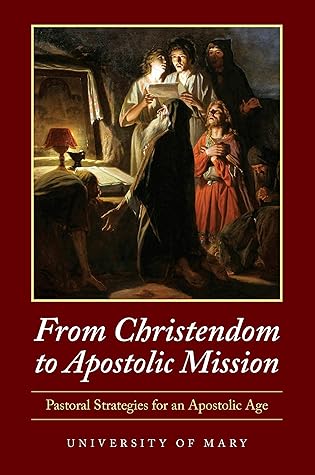More on this book
Community
Kindle Notes & Highlights
Read between
February 5, 2022 - November 16, 2023
In an apostolic time, institutions need to become more self-conscious about their mission, their aims, and their inner spirit. Those who lead and inhabit them need to know with greater clarity what they are doing, why they are doing it, what the likely consequences of taking certain kinds of decisions will be, and how the inner culture of the institution is best maintained against the tide.
their family life, if properly established, will not only provide a good environment for their children but will also be a source of intrigue and hope to many around them looking for a better way to live. Raising a Christian family has always been a serious task; in an apostolic age, it is a missionary adventure.
The difference in attitude between institutions in a Christendom environment and institutions in an apostolic setting is highlighted by two of Jesus’ pastoral teachings. In a Christendom setting, “he that is not against you is for you” (Luke 9:50). In Christendom, as long as there is no active opposition to the ideals of the institution, a certain number of apathetic or poorly trained members will do it no special harm. They will tend to conform, at least passively, to the Christendom orientation of the wider culture, and while they won’t help move things forward or deepen their clarity, they
...more
In showing himself to be the creator, the center of all being, the helper and redeemer of humanity, he did not merely get these ideas going esoterically in peoples’ minds.
The things we do, the kind and manner of activities we engage in, the way we organize our lives, the way we structure the physical world around us, how we order our time, all will have a great deal to do with what we think and believe.
In a Christendom time, the Christian vision is the primary influence in shaping the “architecture” of the society as a whole. Not only church buildings and worship services but the organization of towns, the “soundscape” of bells, the division of the year by feasts and seasons, the way of working and dressing and eating and speaking, all express the invisible world behind the visible one.
Liturgy takes on great importance in this regard as the focal point, the seed crystal, of the visible incarnation of invisible reality. Vatican II’s document on liturgy, Sacrosanctum Concilium, puts the broad principle this way: It is of the essence of the Church that she be both human and divine, visible and yet invisibly equipped, eager to act and yet intent on contemplation, present in this world and yet not at home in it; and she is all these things in such wise that in her the human is directed and subordinated to the divine, the visible likewise to the invisible, action to contemplation,
...more
The priest needs to live in and be animated by a Christian vision and a pattern of practices that touch every aspect of life: a pattern ordered to loving obedience to counter the perennial idol of pride; ordered to chastity to counter the aggressive eroticization in the wider culture; ordered to poverty to counter rampant greed and debasing consumerism; ordered to fraternity and common life to counter isolation and fragmentation endemic to modern life and to provide a witness of brotherly love; ordered to prayer, liturgy, and the unseen world to stay in touch with the most important aspects of
...more
Instead, without simply abandoning the existing institutional structure, the need is for significant resources to be given to developing the kind of apostolic initiatives that produce conversions, especially among the young.
An apostolic mode of running institutions tends to their renewal, but such renewal in the Church always comes from (relatively) small numbers who are given the grace of an intensity of spiritual life for the sake of the whole body.
it is also true that living, breathing disciples make for more problems. Unenlightened zeal, rigoristic attitudes, idiosyncratic or even heretical stances held with great energy, rivalries between individuals and groups, can and do arise. For the stolid administrator this is nothing but trouble, and after all, dead bodies are much easier to arrange than living ones. But the Church needs to be ready for this kind of energetic messiness if she wants to remain alive and capture the wider culture.
In an apostolic age, influence is exerted less by political arts than by a living witness to the Gospel that captures the imagination.
The Church in such a time needs to cultivate a spirit that pursues her true vocation heroically and that spends less time being concerned with what the wider society thinks. This will allow the kind of witness to the Faith that can have a profound influence and can ultimately help to convert the culture. The witness of Mother Teresa and her sisters is an example of the kind of daily heroism called for in such an age.
When many are leaving the Church under the influence of the ruling non-Christian vision or, while still remaining Church members, are complaining about doctrines or disciplines or aspects of its moral vision that don’t square easily with prevailing cultural attitudes, some in the Church want to adjust or do away with the “difficult” aspects of the Gospel in order to keep people in the pews.


